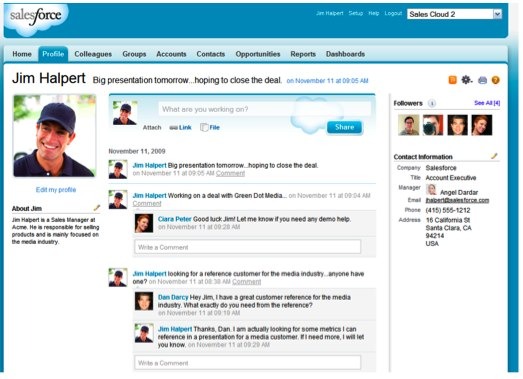2009 was the year in which Marketing Automation really took off. Several new vendors appeared on the market, many existing vendors experienced rapid growth, and Marketing Automation as a term gained popularity among B2B marketers. In this post I want to focus on the trends in Marketing Automation for 2010. I have asked many of the vendors, consultants and thought leaders to give their opinion. The response was overwhelming: see below for all 20 (!) predictions.
There are lots of interesting opinions, from practical to visionary, with consensus on some topics, and differences on others. These are the trends that are mentioned most often:
- Improved ROI & Reporting
- Integration of Social Media, Inbound Marketing and Marketing Automation
- Creation of buyer-centric content
- The need for new analytical skills
- Renewed focus on data quality
- Sales & marketing alignment
I could not agree more with these predictions. (1) We’re at a point where we have lot of data about marketing performance, but it’s a big challenge to turn it into actionable information (2) we’re actively tweeting, blogging and using LinkedIn, but how can that be effectively managed, and how can it be measured? (3) It’s all about the buyer now, so why are you still writing about “my company this, my company that”? (4) Marketing is getting more of a science: creative marketers need to acquire new skills and more people with an analytical background need to enter the profession (5) Data quality is somewhat boring, but it is a prerequisite for effective marketing automation and (6) sales and marketing need act as one team to give buyers the best possible buying experience.
The Contributors
In alphabetical order (click on name to scroll down):
- Adam Blitzer, COO & Co-founder, Pardot
- Erik Bower, Co-founder, Marketbright
- Christoper Doran, CMO, Manticore Technology
- Matt Filios, COO, Net-Results
- Chris Frank, Director of Marketing, TreeHouse Interactive
- Malcolm Friedberg, Principal, Left Brain Marketing
- Kristin Hambelton, Sr Director of Marketing, Neolane
- Megan Heuer, Research Director, SiriusDecisions
- Carlos Hidalgo, President, Annuitas Group
- Kevin Joyce, CMO, Market2Lead
- Scott Mersy, VP Marketing and Products, Genius.com
- Adam Needles, Director, Field Marketing and B2B Marketing Evangelist, Silverpop
- Jeff Ogden, Director of Marketing, Aplicor & President, Find New Customers
- Jeff Pedowitz, President and CEO, The Pedowitz Group
- Maria Pergolino, Sr. Manager, Inbound Marketing, Marketo
- Matthew Quinlan, VP Field Operations, Loopfuse
- David Raab, Raab Associates & author, Raab Guide to Demand Generation Systems
- Mike Volpe, VP of Inbound Marketing, Hubspot
- Steve Woods, CTO, Eloqua
- Fred Yee, CEO, ActiveConversion
The vast majority of leads generated on a website never have a meaningful conversation with a sales rep. The rep may try to contact the prospect several times but will give up after a certain point. If there is no mechanism to pass the lead back to the marketing team (in an automated or semi-automated fashion), the lead is gone forever.
Marketing automation solutions can facilitate remarketing to inactive leads, or so-called lead recycling, which helps drive value from a marketer’s most valuable asset, his or her lead database. An attached CRM system can kick the records back into a marketing automation system’s lead nurturing program and alert the assigned sales rep if the leads become active.
If you aren’t recycling leads (and most marketers aren’t), you are wasting a significant percentage of your marketing dollars.
Erik Bower, Co-founder, Marketbright (No Twitter)
Methods to the madness: Everybody has methodologies, Sales has SPIN, Customer Centric, etc. Marketing has none. In 2010 you’ll start to hear about marketing methods. At Marketbright, we believe Agile Marketing will emerge as a popular methodology so marketing professionals can adapt and survive in 2010.
Social Media Marketing FAIL: In 2010, we’ll see a lot of companies spend a lot of money trying to make a big splash into social networks and many will crash and burn. Social networks like Facebook and Linkedin will start to face customer defections as their networks get bogged down with marketing spam. Marketers will continue to struggle with the new Social Media reality and coming up with smart ways to influence the market’s conversation about their brand.
Twitter splinter: People who “get” twitter will continue to laugh at those who don’t and those who don’t will continue to not care, and to not twitter. A new movement will start called Refusetwits (like Refuseniks).
Spammers Beware: As email clients and service providers adopt features similar to those in Other Inbox, making it nearly impossible to email people you don’t have explicit opt in preferences from. This will place a higher premium on membership management and real, editorialized, well written monthly newsletters.
Resurgence of the Agency: Marketing departments have been trying to go it alone and do their own thing. In 2010, many will start to reengage with creative agencies and marketing consultancies as they realize that they can’t do everything and that finding a good marketing operations person is hard and getting harder.
With shiny new marketing automation platforms now in place, 2010 promises to be the year that marketers begin to create business processes to measure and manage the marketing funnel. Best in class marketing teams successfully implement social media programs as part of their marketing mix, while others struggle to understand how social media fits in the puzzle: Is it sales enablement? Thought leadership? Demand Generation? SEO? Answer: All of the Above! Manticore Technology wishes you a full-funnel in 2010.
1. 2010 will be a year in which companies of all sizes begin to understand and embrace the power and value of marketing automation as a way of engaging with their entire funnel in an automated fashion. As Laura Ramos at Forrester stated in her report several months back, today only 2-5% of B2B companies are utilizing marketing automation/lead management automation. As companies recognize the significance of tying web analytics with email and direct mail campaigns, they can truly get a better understanding of where each of their prospects and leads are in the buying process. Having ‘conversations’ with these prospects as they become more sales-ready keeps the company top of mind when they are ready to buy.
2. The increased number of marketing automation vendors now allows companies to utilize a system without blowing their budget. There are now a number of vendors for every size of company to choose from, and I expect this to continue as this industry continues to heat up.
3. Marketing automation platforms and CRM systems will become more tightly integrated, further bridging the gap between marketing and sales. The virtual ‘wall’ in which marketers throw their leads over to salespeople now comes down, allowing for a collaborative effort of defining and refining qualified leads.
The Rise of Inbound Marketing – The concept of using social media, search engine optimization and blogs together in driving early awareness stage traffic is still a fairly new one. Marketers over 2010 will get much savvier about doing this, however. Beyond the basic tactics for using each tool, there are going to be innovations in marketing automation that will help marketers better manage their efforts, measure results and target prospects.
Cohesive Communication – Many marketers are still struggling to escape from being reactionary to being more proactive. It is a huge shift for marketing teams to make, but a very important one to use marketing automation technology correctly. I see teams that make the shift being better able to compete on a campaign-by-campaign level, better satisfy sales team needs and ultimately being able to drive more pipeline opportunities. A funny thing happens when you start planning out communication—it actually happens, it addresses buying cycle gaps and it becomes more effective because it’s cohesive.
Getting Along – One of the biggest benefits of using a marketing automation solution is that it has the potential to put sales and marketing teams on the same page. The ability to define what a lead really is and then use your marketing automation system to qualify, nurture and pass along those leads is a basic benefit. In 2010 there will be many integrations between marketing automation and CRM systems that will change how teams work together to close business.
Read Chris’s full 2010 predictions on the Treehouse blog.
I think that the business climate is slightly improving and 2010 will provide marketers with a little more flexibility. With that said, I believe the overall trend towards accountability, measurement and marketing ROI will continue to pick up steam. Consequently, marketing automation will play an increasingly important role in helping marketers meet CEO and board expectations as well as get insight into how best to allocate their budgets. The single biggest challenge that automation can address is reporting. At the programmatic level, closed-loop reporting will provide insight into the which tactics are generating the strongest results. Access to this data is the foundation for making budgetary and, when necessary, process changes. At the executive level, ROI reporting by business segment or marketing activity as well as overall marketing investment will enable the marketer to show revenue contribution and make meaningful contributions in discussion about the direction of the company and its products and services.
Kristin Hambelton, Sr. Director of Marketing, Neolane (@neolane)
Most VPs of marketing have come to terms with the fact that budgets won’t be increasing any time soon, so one of the clear themes for 2010 seems to be how marketing automation tools and processes can help organizations navigate the “new normal” and get greater returns on marketing investments.
Lead nurturing must match the complexity of the sales cycle: Despite the typical complexity of B2B sales cycles, B2B marketers have traditionally run very basic campaigns to match basic sales processes. Therefore, their lead generation and nurturing programs often focus only on email and web channels. In the coming year they will increasingly turn to centralized marketing automation systems to manage customer data consistently in order to nurture the right kind of leads in a consistent and coordinated way across communications channels.
Data-centric marketing must pave the way to greater customer intelligence, because the value of data can decline very quickly. By tightly integrating marketing automation solutions with existing data warehouse/master data management platforms, marketers will gain more confidence about the relevancy and quality of their data for improved campaign effectiveness, customer value and ROI.
Streamlining distributed marketing activities is critical to productivity and brand consistency: With many companies’ complex business models spanning multiple industries, geographies and languages, it will be increasingly important to gain more visibility and control over total marketing operations. With distributed marketing teams, marketing automation is key to supporting closed-loop marketing processes and for allowing remote teams to be more collaborative and productive by simplifying and automating key processes.
1. Deal with Bad Data Once and For All: The effective use of marketing automation puts big demands on marketing data, and in most companies that data is in a sorry state. In 2010, Marketing Leaders will have to look at data as a strategic asset and take specific, measureable action to treat it as such. How much can be accomplished with marketing automation depends on the quality of data and the marketing function’s ability to make insightful use of it.
2. Address Legacy Organizational Structure Issues: Marketing cannot embrace the changing buying process if it is organized to support an internal construct of the selling process. Siloed, single-tactic teams must be broken down and rebuilt into an integrated function that can plan and execute multi-touch, buyer-behavior oriented campaigns that fully leverage marketing automation’s power.
3. Use Reporting as a Strategic Tool: Marketing Automation allows vastly better visibility into both buyer behavior and program results. Today, however, most reporting pulled from those tools is focused on telling what happened, and not on illuminating the best path forward. While it is essential for marketing to know what it got in return for a given investment, it’s equally important to take advantage of the power of analytics to define what works, what doesn’t and what actions need to be taken as a result. Testing, predicting and adjusting are words marketing leaders need to get comfortable with in 2010.
See also her recent blog post Five B2B Marketing Surprises From 2009
1. I think developing and implementing a holistic lead management process will be one of the greatest challenges companies face in 2010. This goes beyond just lead scoring and lead nurturing and when done correctly actually can solve many of the other issues that are faced today by organizations but in reality are just symptoms i.e. Marketing and sales alignment. It is an organization wide effort and takes hard work to think through all of the areas including: data, lead planning, lead routing, lead qualification (including scoring), lead nurturing, metrics and technology. While this is a large challenge, it is one that will pay one of the highest returns.
2. I think measurement will continue to be a challenge for organizations as it has been for years. However with the introduction of social and inbound it takes on a whole new face and some interesting layers. Organizations will need to first determine what they are looking to measure and therein lies one of the key challenges. Organizations often don’t know what or why they want to measure, so they try to measure everything. Going into this year, organizations will need to determine what key metrics they need and it is recommended that they focus these measurements around the buying cycle and buying behavior.
3. The last major challenge marketing departments will face is the adoption of technology. With marketing automation being on the rise, the adoption of this technology is a must for most organizations, but it will also require that organizations determine the ramifications of such a purchase. How will it impact their global execution? What will it do to their resource allocation and how will they provide the value? These questions should be answered by companies before making the purchase.
In 2010 CEOs will start to loosen the purse strings and invest again in marketing and sales. The budget won’t flood back to previous levels but rather trickle back, and the Marketing VP will have to account more vigorously than ever for each marketing investment. Therein lies the first business challenge of Marketing VPs: how to turn your organization into a measurable, accountable, productive machine, with KPIs and believable results data.
The second challenge will be in adapting their organization to take advantage of new ways of marketing, new media, new technologies. The choices of tools available to marketing are increasing rapidly, and the mix of marketing folks will need to shift a little more to the left brain marketers. The second challenge will therefore be to define and staff marketing operations roles in the organization.
The recession reminded companies of the value of marketing to their installed base, and to their in house lists. But if your data hygiene is on par with a New York subway restroom, marketing to the in house database will fail to meet expectations. The challenge is to have complete, accurate, current, and deep data on your prospects and customers so you can market to them effectively, and have the processes in place to slow the decay of the database.
Scott Mersy, VP Marketing and Products, Genius.com (@smersy)
Marketers need to connect Inboud Marketing to Marketing Automation. There’s a lot of discussion about trading traditional outbound marketing methods for inbound ones. However, Inbound Marketing by itself isn’t enough in a complex selling environment. VPs of Marketing need to maximize the revenue opportunity from inbound leads and optimize the burgeoning customer relationship after an expression of inbound interest is expressed. Marketing Automation enables delivery of appropriate messages, emails, website personalization – all designed to drive a “right-time” interaction with sales.
Marketers are challenged to measure further down the funnel. When measuring number of leads and cost per lead, marketing’s goals aren’t aligned with sales. Marketing talks about generating “enough” leads, but Sales inevitably (and rightfully) complains about the quality of the leads because, more often than not, the quality is sub-par. With proper lead nurturing enabled by marketing automation, marketing is held to much higher standards. Conversion metrics all the way through to revenue will quickly become the standard way to measure marketing.
Marketers must be publishers. Publish or perish is no longer just the mantra of academia, it’s a key aspect of a company’s marketing strategy. We need to keep publishing, but, more importantly, we need to engage in conversations. Without listening, “conversations” are simply monologues. Genius.com’s Barbra Gago (@barbragago) recently published a great slideshare to help marketers learn how to create great content.
Adam Needles, Director, Field Marketing and B2B Marketing Evangelist, Silverpop (@abneedles)
I think the greatest issue B2B marketing executives will face in 2010 is two-fold: 1.) responding to the continuing shift in power from vendor to buyer that Web 2.0 and Web 3.0 are enabling and 2.) consequently improving their ability to re-cast marketing strategies and tactics in a buyer-centric context.
This power shift is not new; in fact, it is the Groundswell that Charlene Li wrote about and is a key focus of Paul Greenberg’s new Fourth Edition of CRM at the Speed of Light. But marketers awareness of the dynamics of this power shift and their ability to respond to it are just maturing.
Marketing automation is playing a key role as a central platform for responding to and delivering buyer-centric marketing programs; moreover, the agenda of marketing automation is rapidly expanding to address the continuity of buyer dialogue from inbound/upstream engagement – through mid-stream nurturing — to hand-off to a sales team member.
So in my mind 2010 will be the year of our shift from thinking about marketing automation as a way to gain operational efficiency to a way to reposition marketing — becoming more buyer-centric and ensuring continuity of dialogue with the buyer throughout his/her buying process and at all touch points. In fact, I believe marketing automation will be the catalyst for a new mass one-to-one style of engagement, that was not possible before and that is critical to winning in the ‘brave new world’ of B2B marketing we’re faced with.
1. Learning the personas and issues for target customers so we can create Problem to Solution marketing stories.
2. Better align sales and marketing to empower sales to close faster.
3. Document the value of marketing for the executive leadership team.
I believe this year will be one of explosive growth for the category. I predict that over 1000 new companies will implement marketing automation tools and processes this year. There will be a strong emphasis on monetizing social media, achieving closed loop reporting, and improving campaign effectiveness. Lead Scoring will become a common standard and more marketers will start to use multi-touch campaigns for both existing customers and new prospects. This will be the year of Revenue.
Maria Pergolino, Sr. Manager, Inbound Marketing, Marketo (@InboundMarketer)
Marketing Automation will continue to be one of the biggest initiatives for B2B Marketing Executives in 2010, primarily because of the speed at which the return on the investment can be achieved. While the implementation, process, and tools marketers select will be the tactical challenges faced by the marketing team, this will improve the marketing department by making:
1. Marketing success transparent to the entire organization, particularly the executive staff and sales team, because of the ability to analyze marketing campaign effectiveness and influence and share this success via dashboards and reports.
2. More out of one of the organizations most valuable assets, the contact database, by reinvigorating leads that are already known. This will be done with lead recycling, remessaging, and highly personalized and segmented offers. This also includes nurturing programs to grow and enhance relationships with current customers, helping make them more profitable.
3. Marketers able to score and nurture leads on activities outside of emails and the company website. This includes social media networks, partner sites, blogs, and more. This social marketing automation will not replace the current efforts of those already using marketing automation, but will enhance programs, improving results and creating a better understanding of the return that can be achieved through social media marketing.
Matthew Quinlan, VP Field Operations, Loopfuse (@mattquinlan)
Determining leadsource efficiency and reallocating the limited leadgen budget dollars to the most efficient sources. (Google adwords, banner ads on sites A/B/C, purchasing prequalified leads from companies like Tippit, purchasing email lists from vendor A/B/C, event sponsorships A/B/C, etc.)
Designing more sophisticated (non-linear) marketing programs that are more adaptive to the user’s behaviors along the way. (Regardless of what you may have seen, every program DOES NOT have to begin with an outbound email).
Focus within social media. New social media channels are appearing weekly and while they may not have hard costs, targeting a channel like Twitter effectively takes time and effort. Measuring the impact of each channel will allow you to pick/choose the key channels to focus upon.
As to the coming year, we’ll certainly see continued deployment of tools to market through social media and to give salespeople access to marketing automation data. I also think we’ll see more sophisticated reporting on marketing results, in particular a better job of connecting actual sales (via opportunities) to campaigns. I’d like to think we’ll see greater recognition of the importance of testing, but that could be wishful thinking on my part. One particular area I think is ripe for greater attention is really dealing with the need for more precisely targeted content. Many marketers find the volume of content they need to create is a stumbling block for better marketing automation; at the same time, they also lack ways to determine which content should be sent to particular people in particular circumstances. I think there is a common automated solution to both these problems that involves breaking content into snippets and delivering the right snippet at the right moment. I haven’t seen anyone actually address this in quite those terms, but it seems like a solution to a very pressing problem.
Mike Volpe, VP of Inbound Marketing, Hubspot (@mvolpe)
2010 will be the year of inbound marketing for two reasons.
First, the euphoria of social media marketing will turn into a hangover, followed by the epiphany that social media is just one tool, and the path to success is paved with a comprehensive inbound marketing strategy, not using one tool.
Second, marketers will realize that only automating the bottom of their funnel through lead nurturing does nothing to grow the top of the funnel, and to maintain a healthy long term pipeline, they need a complete inbound marketing strategy to attract more leads to their company at a low cost.
2010 will bring interesting challenges to marketers. First, there will be a continuation of the expansion in the number of “touches” that a prospect has prior to closing – with many of those touches via social media channels. With this, there will be a deepening of the realization that assigning the revenue to the last touch only is not just incorrect, but very misleading. With that, 2010 will bring an increased focus on understanding influence, and attributing revenue, across all touches in the marketing process.
Secondly, the content we create will begin to change significantly. As social media approaches push marketers to be more engaged and less broadcasters, we will be pushed to re-tool to create more content, less “polished” than previously, but more interesting and shareable. With this, subject matter experts will have to be more involved in the content creation process as the high level messaging will no longer be sufficient.
The third challenge we will face in 2010 as marketers will be skills based. As marketing engages deeper in the buying funnel, contributing significantly to the overall lifecycle of a lead, marketers will be required to structure their thinking in terms of business process flows. The data, timing, exceptions, and dispositions of scoring a lead, handing the lead to sales, and having sales act on that lead will require a deeper understanding of data, process, and automation than we in marketing have historically been called on to have.
2010 will be a true turning point year as the change in our buyers’ buying processes has become so profound that we can no longer engage with them in an old way. The challenges and opportunities are there for us, and those who tackle them will see 2010 as a year of significant successes.
As one of the earlier vendors in this space, we’ve seen many changes (new vendors come in, some go dormant or never get traction), and predictions (eg when SFDC provides MA, what will happen to you?) and thus our thoughts for the new year are somewhat pragmatic. Here are the ones we think will stand out:
1. Sales will be more engaged in MA leading to more buy-in by the rest of the company
2. Social media will be seen as important but not the be all in marketing – and needs to be incorporated
3. These products will extend to complex sales cycles in B2C – and to other markets around the world
4. What matters in the end is pipeline and revenue – senior management doesn’t care how you do it.
The industry is far from being mature, with many potential customers still learning about MA. And the feature list is endless due to the new integration possibilities provided by SaaS every day. 2010 promises to be very exciting, yet volatile due to ongoing changes. We hope it’s the year that the hype diminishes, as it hurts the industry and the customers.


 Hubspot Show & Tell
Hubspot Show & Tell
 The full title of this event is “Lead Management: Tackling the Top 5 Questions about the Lead Cultivation, Qualification and Hand-Off Process”. It’s presented by Sean Donahue, Editor, MarketingSherpa and Jennifer Horton, Best Practices Consultant, Eloqua. During the webinar, they will cover practical strategies that highlight the best way to attract new leads, how to find the right approach for the type and timing of messages, and when to complete the transition to sales.
The full title of this event is “Lead Management: Tackling the Top 5 Questions about the Lead Cultivation, Qualification and Hand-Off Process”. It’s presented by Sean Donahue, Editor, MarketingSherpa and Jennifer Horton, Best Practices Consultant, Eloqua. During the webinar, they will cover practical strategies that highlight the best way to attract new leads, how to find the right approach for the type and timing of messages, and when to complete the transition to sales. Do you want to nurture new leads, existing leads or both?
Do you want to nurture new leads, existing leads or both? The CEO/CFO of your organization may be asking you to measure Marketing Campaign ROI to determine marketing’s contribution to revenue. The question is straight forward, yet what you may have already discovered is that the answer on what to measure and how to measure is not simple.
The CEO/CFO of your organization may be asking you to measure Marketing Campaign ROI to determine marketing’s contribution to revenue. The question is straight forward, yet what you may have already discovered is that the answer on what to measure and how to measure is not simple.



